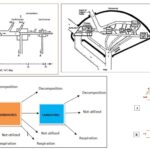glycolysis step
glycolysis step
Please login to submit an answer.
Glycolysis is a fundamental metabolic pathway that converts one molecule of glucose (a six-carbon sugar) into two molecules of pyruvate (a three-carbon compound). This process occurs in the cytoplasm of cells and is the first step in both aerobic and anaerobic respiration. Glycolysis consists of 10 enzyme-catalyzed steps, which can be divided into two phases: the energy investment phase and the energy payoff phase.
Energy Investment Phase (Steps 1–5):
Step 1: Phosphorylation of Glucose
Enzyme: Hexokinase (or glucokinase in liver cells)
Reaction: Glucose + ATP → Glucose-6-phosphate (G6P) + ADP
This step traps glucose within the cell and destabilizes it for further reactions.
Step 2: Isomerization of G6P to F6P
Enzyme: Phosphoglucose isomerase
Reaction: Glucose-6-phosphate ↔ Fructose-6-phosphate (F6P)
This rearrangement prepares the molecule for subsequent phosphorylation.
Step 3: Phosphorylation of F6P to F1,6BP
Enzyme: Phosphofructokinase-1 (PFK-1)
Reaction: Fructose-6-phosphate + ATP → Fructose-1,6-bisphosphate (F1,6BP) + ADP
This is a key regulatory and irreversible step in glycolysis.
Step 4: Cleavage of F1,6BP
Enzyme: Aldolase
Reaction: Fructose-1,6-bisphosphate ↔ Glyceraldehyde-3-phosphate (G3P) + Dihydroxyacetone phosphate (DHAP)
This step splits the six-carbon sugar into two three-carbon sugars.
Step 5: Isomerization of DHAP to G3P
Enzyme: Triose phosphate isomerase
Reaction: Dihydroxyacetone phosphate ↔ Glyceraldehyde-3-phosphate
This ensures that both molecules proceed through the same subsequent steps.
Energy Payoff Phase (Steps 6–10):
Step 6: Oxidation and Phosphorylation of G3P
Enzyme: Glyceraldehyde-3-phosphate dehydrogenase
Reaction: Glyceraldehyde-3-phosphate + NAD⁺ + Pi ↔ 1,3-Bisphosphoglycerate (1,3-BPG) + NADH + H⁺
This step produces NADH and adds a high-energy phosphate group
Step 7: Substrate-Level Phosphorylation
Enzyme: Phosphoglycerate kinase
Reaction: 1,3-Bisphosphoglycerate + ADP ↔ 3-Phosphoglycerate + ATP
This is the first ATP-generating step in glycolysis.
Step 8: Conversion of 3-Phosphoglycerate to 2-Phosphoglycerate
Enzyme: Phosphoglycerate mutase
Reaction: 3-Phosphoglycerate ↔ 2-Phosphoglycerate
This rearrangement prepares the molecule for dehydration.
Step 9: Dehydration of 2-Phosphoglycerate
Enzyme: Enolase
Reaction: 2-Phosphoglycerate ↔ Phosphoenolpyruvate (PEP) + H₂O
This step creates a high-energy enol phosphate.
Step 10: Second Substrate-Level Phosphorylation
Enzyme: Pyruvate kinase
Reaction: Phosphoenolpyruvate + ADP → Pyruvate + ATP
This final step yields ATP and forms pyruvate, the end product of glycolysis.
Net Energy Yield from Glycolysis:
ATP Consumed: 2 (Steps 1 and 3)
ATP Produced: 4 (Steps 7 and 10, two ATP per step as each occurs twice per glucose molecule)
Net ATP Gain: 2
NADH Produced: 2 (Step 6)
- Share on Facebook
- Share on Twitter
- Share on LinkedIn
Helpful: 0%




